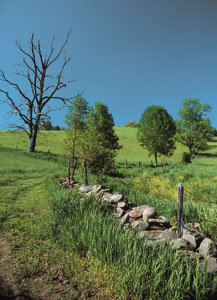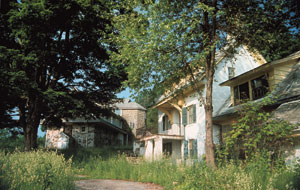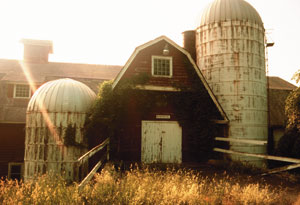

| Now or Never | |||
Lusscroft Farm Story and photos by Donna Traylor As historic sites go, Lusscroft Farm is one of a kind. Located in the northwest corner of Sussex County, these 578 acres have a rich and diverse past. Between 1914 and 1930, James Turner, a Montclair stockbroker, invested the considerable fortune of $500,000 to make Lusscroft a perfect model of dairy farming, employing the most innovative practices of the time based on scientific research. The property is located on Neilson Road in Wantage Township and contains 23 buildings including the Turner Mansion, the Manager's Dwelling, the spectacular Outlook Lodge and the dairy barn and farm structures. The land includes fields and pastures, ponds, woodland and various barnyards.
To promote agricultural research and education, Turner donated his original 1,050 acres and three separate farm units to the State of New Jersey in 1931, the only stipulation being that the land be used "in every expedient way toward promoting social progress and welfare." Along with the land went the Guernsey and Holstein herds, horses, tractors, modern dairy buildings, employee cottages and a complete line of farm machinery. Lusscroft became one of the first farms devoted to dairy research in the United States, serving from 1931 until 1970 as the North Jersey Dairy Branch of the New Jersey Agricultural Experiment Station of Rutgers University. The farm gained national prominence as the site where artificial insemination of dairy cows was developed. In addition to developing breeds of cows that were healthier and produced higher content of butter fat in milk, artificial insemination provided a safety mechanism to farmers who no longer had to accommodate ornery bulls on their premises. For the duration that the research facility was open, New Jersey was at the forefront in the development of grassland farming, artificial livestock breeding and production testing for a safe and healthful milk supply. Lusscroft's next chapter was to serve as a 4-H Youth Center for Outdoor Education, although only 578 acres of the original 1,050 were used. The center opened in 1973 to just under 1,000 campers and closed in 1996 due to declining enrollments and increases in maintenance expense. In 2002, the State of New Jersey transferred administrative control of Lusscroft over to the New Jersey Department of Environmental Protection, Division of Parks and Forestry. It now comes under the management of High Point State Park with a Memorandum of Understanding (MOU) with the State Agriculture Development Committee who administer the State's Farmland Preservation program. The MOU states that the land still in agriculture use will remain so.
The General Management Plan that was presented to the public during
a July 2004 meeting outlined three possible alternatives for this
property. Approximately 400 people attended this meeting to learn
of the project and give their views. Afterward, 63 written responses
were received. 97% of the responses favored the first two alternatives,
or a combination of both. Agritourism and ecotourism can be a vital component of Lusscroft's survival. Shelburne Farms in Vermont is a good example of what can be done at Lusscroft. Like Lusscroft, Shelburne is protected through easements to remain in agricultural and environmental use. It has an agricultural component, utilizing its land to pasture a dairy herd, and producing a value-added product: the farm's own cheese for public sale. Shelburne opens its many facilities to school children for agricultural and environmental education programs and uses its mansion for public dining and overnight accommodations. With state and public support, similar uses can occur on the Lusscroft property; here is an opportunity for the best type of public/private partnership. The mechanisms for stabilizing the property and buildings on Lusscroft Farm are in place. The site's tremendous historic value for the state and national dairy and agricultural industry is well established. Limited funds are available to NJDEP for rehabilitation of buildings on state-owned property. Finally, a non-profit "Friends" group, the Heritage and Agriculture Association, Inc. has begun a grassroots campaign to promote the adaptive re-use of Lusscroft's assets. Preparing the farm for public "consumer" use requires a long-range plan, a well-organized effort to raise private donations, and a heavy dose of "sweat equity" from the group's members. But it is not unrealistic to hope for Lusscroft's gates to be fully open in three to six years. In the meantime, the property will begin hosting birding and nature walks, horseback riding as trails are opened and perhaps various fundraising events. Anyone who would like to join the Heritage and Agriculture Association, Inc. should contact their president, Sue Gerber, at 973-875-2764. The Lusscroft General Management Plan is available through the NJDEP’s Division of Parks and Forestry. Lusscroft events and continuing information will be available at www.sussexfarmvisits.com. With its rich agricultural history, unique buildings, and breathtaking scenery, Lusscroft Farm will become a vital Sussex County destination for all. |
|||
|
Sussex County Agriculture Development Board |
Related Links Sussex County Harvest, Honey & Garlic Festival
 At
one time in its history, Lusscroft housed the finest purebred Guernsey
herd in the region. Cows were the single most important factor
in making dairy farming profitable, and Turner invested his money
wisely, while using the latest machinery, seed and rural electrification.
Ultra-modern, electrically lighted barns with automatic water troughs
and artificial ventilation housed the herd. The Sussex Independent
wrote in 1916 of "a fine Jersey dairy upon the Turner farm,
each sire being worthy to adorn the pages of the most expensive
printed catalogue issued by the most exclusive publishing houses
in the country. A specialty is also made of poultry, prime Leghorn
fowls having the preference. These aristocratic fowls are so comfortably
housed that the fierce mountain gales bring to them no terror.
There are also turkeys, proud gobblers and fine hens, and well
bred swine."
At
one time in its history, Lusscroft housed the finest purebred Guernsey
herd in the region. Cows were the single most important factor
in making dairy farming profitable, and Turner invested his money
wisely, while using the latest machinery, seed and rural electrification.
Ultra-modern, electrically lighted barns with automatic water troughs
and artificial ventilation housed the herd. The Sussex Independent
wrote in 1916 of "a fine Jersey dairy upon the Turner farm,
each sire being worthy to adorn the pages of the most expensive
printed catalogue issued by the most exclusive publishing houses
in the country. A specialty is also made of poultry, prime Leghorn
fowls having the preference. These aristocratic fowls are so comfortably
housed that the fierce mountain gales bring to them no terror.
There are also turkeys, proud gobblers and fine hens, and well
bred swine."

